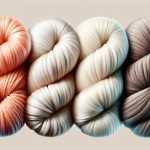You want to know which fabric reigns supreme in strength? Look no further than this comprehensive guide.
From natural fabrics like cotton and wool to synthetic powerhouses such as nylon and polyester, we'll delve into the nitty-gritty of each contender.
We'll explore how blended fabrics like poly-cotton and spandex-blends combine the best of both worlds.
Not to mention, we'll uncover the impact of intricate weave patterns on a fabric's durability.
And don't forget about the rigorous testing methods that separate the strong from the weak.
Get ready to gain mastery over the world of fabrics and discover which one truly stands as the strongest of them all.
Key Takeaways
- Silk is surprisingly strong, even stronger than steel in terms of tensile strength.
- Nylon is a synthetic fabric with high durability, commonly used in activewear and luggage.
- Blended fabrics combine the strengths of different materials, resulting in enhanced tensile strength, abrasion resistance, and dimensional stability.
- Weave patterns, such as twill and satin weave, determine fabric strength and characteristics. Twill weave is known for durability and resistance to wrinkles, while satin weave produces luxurious and shiny fabrics.
Natural Fabrics
When considering natural fabrics, you should focus on understanding their inherent strength and durability. Let's start by comparing cotton and silk.
Cotton is known for its breathability and softness, making it a popular choice for everyday wear. However, when it comes to strength, silk takes the lead. Silk may seem delicate, but it's surprisingly strong, even stronger than steel in terms of tensile strength. This makes silk a durable and luxurious choice for various garments.
Now, let's delve into wool versus linen. Wool is renowned for its warmth and insulating properties, but it's also remarkably strong. The natural crimp in wool fibers gives it resilience and elasticity, making it resistant to tearing and wrinkling.
On the other hand, linen, while lightweight and breathable, isn't as strong as wool. Linen fibers are stiff and brittle, making the fabric prone to wrinkles and breakage.
Synthetic Fabrics
Synthetic fabrics offer a wide range of options for durable and resilient materials. When it comes to durability comparison, synthetic fabrics often outperform natural fibers. They are engineered to withstand wear and tear, making them ideal for high-traffic applications. The production process of synthetic fabrics involves the use of chemical compounds and advanced manufacturing techniques to create strong and long-lasting materials. Below is a comparison table showcasing the durability of different synthetic fabrics:
| Synthetic Fabric | Durability Rating | Common Uses |
|---|---|---|
| Nylon | High | Activewear, luggage |
| Polyester | Very High | Outdoor furniture, |
| upholstery | ||
| Acrylic | Moderate | Outdoor fabrics, |
| carpets |
As seen in the table, polyester stands out for its very high durability, making it a popular choice for various applications. Understanding the production process and durability of synthetic fabrics can help you make informed decisions when choosing the strongest fabric for your specific needs.
Blended Fabrics
Blended fabrics combine the strengths of different materials, offering a versatile and durable option for various applications. When considering the durability of fabrics for your specific needs, exploring the characteristics of blended fabrics can provide valuable insights.
Blended fabric strength is derived from the combination of fibers, such as cotton-polyester blends or wool-silk blends. These blends often exhibit enhanced tensile strength, abrasion resistance, and dimensional stability compared to single-fiber fabrics. Fabric durability testing of blended fabrics involves assessing factors like pilling resistance, colorfastness, and tear strength to ensure their suitability for different uses.
Blended fabrics are commonly used in clothing, upholstery, and technical textiles due to their ability to offer a balance of comfort, performance, and longevity. When selecting a blended fabric, consider the intended use and the specific properties required. Understanding the composition and performance characteristics of blended fabrics empowers you to make informed decisions, ensuring that the chosen fabric meets your durability and strength requirements.
Weave Patterns
Exploring different weave patterns is essential for understanding the strength and durability of various fabrics. Two common weave patterns that significantly impact fabric strength are twill weave and satin weave.
Twill weave is characterized by its diagonal parallel ribs, which make the fabric strong and long-lasting. This weave pattern is renowned for its durability and resistance to wrinkles, making it a popular choice for sturdy materials such as denim and tweed.
On the other hand, satin weave creates a smooth and lustrous surface due to its long floats, where the warp yarns pass over multiple weft yarns. While satin weave produces luxurious and shiny fabrics like satin and sateen, it tends to be less durable than twill weave due to its long float length.
Understanding these weave patterns allows you to make informed decisions when choosing fabrics for various applications. Whether you seek durability, smoothness, or sheen, the weave pattern plays a crucial role in determining the strength and characteristics of the fabric.
Fabric Testing Methods
To determine the strength of fabrics, you can employ various fabric testing methods. Understanding the tensile strength and fabric durability is crucial in determining the overall quality and performance of a fabric.
Here are four fabric testing methods to help you assess these important factors:
- Grab Test: This method involves applying force to a small section of the fabric to measure its resistance to tearing. It provides valuable insights into the fabric's strength and durability.
- Tensile Strength Test: By subjecting the fabric to controlled tension until it breaks, this test helps determine the maximum amount of force the fabric can withstand. It's a key indicator of the fabric's overall strength.
- Abrasion Resistance Test: This method involves rubbing the fabric against a rough surface to simulate wear and tear. It assesses the fabric's ability to withstand friction and maintain its integrity over time.
- Bursting Strength Test: This test measures the maximum pressure the fabric can endure before bursting. It's particularly important for fabrics used in applications where they may be subjected to high levels of pressure.
Employing these fabric testing methods can provide valuable insights into the strength and durability of different fabrics.
Frequently Asked Questions
What Is the Average Cost of Producing Natural Fabrics Compared to Synthetic Fabrics?
When comparing the cost of producing natural fabrics to synthetic fabrics, you'll find that natural fabrics generally have a higher production cost due to the sourcing and processing of raw materials, as well as the sustainability impact.
Are There Any Specific Environmental Considerations With the Production of Blended Fabrics?
When it comes to blended fabrics, the environmental impact can vary depending on the production methods and sustainability practices. Understanding these factors can help you make informed choices for more eco-friendly clothing options.
How Do Different Weave Patterns Affect the Durability of a Fabric?
Different weave patterns impact fabric strength and durability. Some weaves, like twill, are sturdier than others. Additional treatments, like coatings or finishes, can also enhance durability. Fabric testing ensures quality, but consider the environmental impact too.
What Are the Most Common Fabric Testing Methods Used by Manufacturers to Determine Strength?
To determine fabric strength, manufacturers commonly use tensile strength tests. These assess how much force a fabric can withstand before breaking. Other fabric testing methods include evaluating durability, weave patterns, treatments, and considering environmental impact.
Can Certain Fabrics Be Strengthened Through Additional Treatments or Processes?
To enhance fabric durability, innovative processes like additional treatments can strengthen certain fabrics. These treatments, such as chemical coatings or fiber blending, can significantly improve the strength and resilience of the fabric.
- Tetron Fabric for Marine Applications: Durability and Use Cases - June 18, 2025
- Tetron Fabric for Outdoor Furniture: Weather Resistance and Care - June 18, 2025
- Tetron Fabric for Wall Coverings: Style and Application Tips - June 18, 2025







